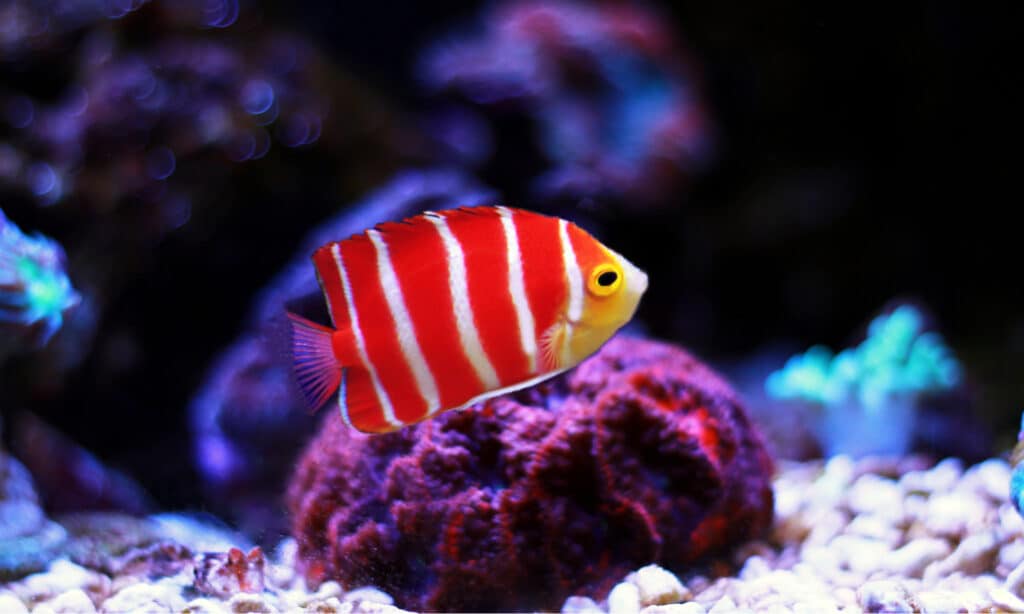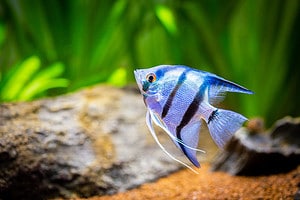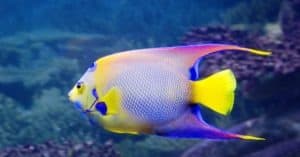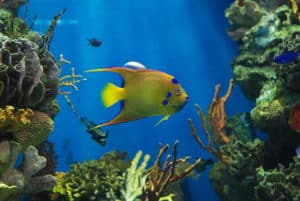Angelfish are a type of cichlid fish that can be found in either marine or freshwater habitats. There are over 50 different varieties of angelfish belonging to 7 genera. Each species ranges in color and size, with marine angelfish being the largest and most colorful. They make popular additions to home aquariums, and most species are plentiful in the aquarium trade industry.
So, if you are looking to get a pet angelfish, this article will discuss the expected costs and considerations.

Angelfish Price Range: How Much Do These Fish Cost?
The price of an angelfish can vary depending on the species. Freshwater angelfish are more widely available and affordable than marine angelfish, and therefore cheaper. You can expect to spend between $3 to $50 for freshwater angelfish, and around $150 to $1,500 for marine specimens.
Here’s a breakdown of the expected costs for both freshwater and marine angelfish:
Freshwater Angelfish
| Type of Angelfish | Cost |
|---|---|
| Zebra angelfish: | $3–$18 |
| Marbled angelfish: | $10–$40 |
| Black lace angelfish: | $5–$28 |
| Gold angelfish: | $6–$30 |
| Koi angelfish: | $10–$50 |
| Blue blushing angelfish: | $15–$40 |
| Platinum angelfish: | $10–$30 |
| Clown angelfish: | $15–$48 |
| Veil angelfish: | $20–$45 |
| Panda angelfish: | $20–$100 |
| Leopard angelfish: | $8–$40 |
Marine (Saltwater) Angelfish
| Type of Angelfish | Cost |
|---|---|
| French angelfish: | $100–$400 |
| Emperor angelfish: | $400–$1,500 |
| Pygmy angelfish: | $50–$150 |
| Regal angelfish: | $200–$600 |
| Queen angelfish: | $150–$400 |
| Peppermint angelfish: | 2,000–$30,000 |
| Flame angelfish: | $50–$200 |
| Blueface angelfish: | $150–$500 |
| Coral beauty angelfish: | $50–$200 |
What Is The Most Expensive Angelfish in The World?

The Peppermint Angelfish’s unique colors make it look like the candy for which it is named.
©Vojce/Shutterstock.com
The peppermint angelfish (Centropyge boylei) is the most expensive marine angelfish in the world. They are sold for thousands of dollars at a whopping $30,000. Peppermint angelfish are extremely rare in the aquarium trade, as they are difficult to breed and care for. Only a specialized diver can capture peppermint angelfish since they inhabit depths of 200 to 400 feet in the Southern Pacific Ocean.
Unfortunately, many of the peppermint angelfish up for sale are wild-caught and have been removed from their wild habitat to be kept as pets. It is best to not support the markets that illegally catch and sell peppermint angelfish.
Factors Affecting Angelfish Prices
Several factors can influence the price of an angelfish, which we will discuss below.
- Species: Certain species of angelfish are more expensive than others, primarily because of their rarity and availability. Marine angelfish are going to be pricier than freshwater angelfish regardless of their size or age.
- Size: The larger an angelfish is, the more expensive it might be. Young angelfish are very vulnerable and still have a lot of growth to do over the next few months. If you purchase an angelfish that is already fully grown, they are going to be less vulnerable and have developed their true adult colorations. Furthermore, fully grown angelfish can also be used for breeding purposes and breeders do not need to wait for their angelfish to mature.
- 1,5Quality: A well-bred and healthy angelfish is going to cost more since you are paying for a higher quality angelfish. This is primarily why angelfish breeders will price their angelfish higher than most large-chain pet stores.
- Availability: Some species of angelfish are difficult to breed in captivity. They are not widely available, and they are found in limited numbers within the aquarium trade. Therefore, you will pay for an angelfish’s rarity and availability as pets. This is why most marine angelfish are pricier than freshwater angelfish.
Angelfish Purchase Considerations and General Care
| Supplies | Cost |
|---|---|
| Tank: | $60–$1,900 |
| Filter: | $10–$45 |
| Sump: | $12–$60 |
| Water treatments: | $3–$36 |
| Protein skimmer: | $30–$80 |
| Heater: | $10–$50 |
| Net: | $1–$5 |
| Substrate: | $8–$38 |
| Plants, rocks, and décor: | $10–$65 |
| Lighting: | $12–$40 |
| Gravel vacuum/siphon: | $2–$25 |
| Bucket: | $1–$10 |
| Food and supplements: | $5–$30 |
Before getting angelfish, it is important to fully understand their care and housing requirements. There are many species of angelfish available as pets, and their care requirements can vary between the species.
Keep in mind that marine and freshwater angelfish will have very different tank setups and water conditions. You will need to do a lot of research on the type of angelfish you are keeping and learn the specifics of their diets, water quality, temperature, and tank size.
Tank Size and Setup
All angelfish require a spacious, heated, and filtered tank above 20 gallons in size. Angelfish should never be housed in small aquaria like bowls or vases. Those types of aquaria do not offer angelfish the space they need to thrive. Instead, angelfish should be housed in rectangular or very large vertical fish tanks.
The exact size of their tank will vary depending on the species, but it should be as large as possible. Most tanks around 20 to 125 gallons in size cost between $60 to $1,200.

Black is a popular coloration in angelfish.
©Saad315/Shutterstock.com
In terms of the tank setup, freshwater angelfish prefer plenty of live plants in their tank. Live plants make them feel secure while helping to keep the water filtered and oxygenated. Any freshwater plants that grow in tropical conditions are suitable for freshwater angelfish. You can grow the plants in a sandy or fine-gravel substrate, which an angelfish experiences in the wild.
Marine angelfish need to be kept in large tanks which are usually expensive. For example, queen angelfish require a tank of around 150 to 200 gallons in size. These big tanks can cost a couple of thousand dollars new. Marine angelfish can benefit from having a protein skimmer and sump running in their tank.
You can expect to spend more on a marine angelfish tank setup and supplies than freshwater angelfish.
Temperature
Both marine and freshwater angelfish naturally inhabit tropical waters. They do not adapt well to cold or fluctuating water temperatures which can cause them to feel stressed. You need to keep their tank heated at a stable temperature. While a gradual temperature drop of 1 to 2 degrees isn’t concerning, constant fluctuating temperatures are. Keeping an aquarium thermometer in the tank allows you to monitor their temperature and make necessary adjustments.
Most marine angelfish should be kept at a temperature range between 70 to 82 degrees Fahrenheit. Whereas freshwater angelfish are comfortable at temperatures of 75 to 80 degrees Fahrenheit.
Most aquarium heaters cost around $10 to $50, which is relatively inexpensive.
Water Parameters
Angelfish are very sensitive to changes in water quality and require specific parameters to thrive. The water parameters for angelfish can vary according to their species and wild habitat. However, all species of angelfish need to be kept in a fully cycled tank. Their tank needs to be set up and run for 4 to 12 weeks before they can be added in.
The tank needs to establish beneficial bacteria that will help keep the ammonia, nitrite, and nitrate levels under control. If you were to add angelfish to an uncycled aquarium, they usually won’t live much longer than a few days. Even the slightest traces of ammonia or nitrite can kill an angelfish.
- pH Range: 6.0 to 8.0
- Water hardness: 54 to 145 ppm
- Ammonia level: 0 ppm
- Nitrite level: 0 ppm
- Nitrate level: Below 20 ppm
Diet
Most angelfish are omnivores but lean more towards a carnivorous diet. In the wild, angelfish eat small crustaceans, insects, fish, worms, and some aquatic plants. However, marine angelfish feed on jellyfish, sponges, plankton, and bryozoan as well.

Angelfish should get most of their nutrients from a commercial flake, pellet, or granular food. The food should be specifically formulated for the type of angelfish you are keeping. Additional dietary supplements like bloodworms, brine shrimp, prawns, krill, and sponges should be included in their diet. You do not have to offer them supplements every day as only two to four times a week is necessary.
Most angelfish food costs between $5 to $30, with pellets being the more expensive option.
Compatibility
Most species of angelfish are compatible in community aquariums. Freshwater angelfish in particular can be kept with various tank mates that are peaceful, non-carnivorous, and a similar size. Some good angelfish tank mates include the neon tetra, gourami, swordtails, mollies, and ram cichlids. Whereas most marine angelfish can be kept with damsels, eels, triggerfish, and even tangs.
It is important to note that freshwater fish are highly social fish. They need to be kept in groups of five or more so that they can form a shoal. They should never be housed alone since this can be stressful for them. Freshwater angelfish feel safer in groups and naturally form large shoals in the wild.
Angelfish Care: Resources and Platforms
- Seriously fish
- Aquarium Co-Op
- Ocean Info
- The Angelfish Society & Forum
- Fish Keeping Advice
- Ocean Conservancy
We recommend the following YouTube videos if you are interested in learning more specific aspects of angelfish care.
In Conclusion
Most angelfish are relatively inexpensive, and it is their supplies, tank, and ongoing food costs that are pricey. Freshwater angelfish and their supplies are generally cheaper than marine angelfish, although both make great pets.
The photo featured at the top of this post is © iStock.com/TatianaMironenko
Thank you for reading! Have some feedback for us? Contact the AZ Animals editorial team.






